After a period of intense volatility, gold prices have begun stabilizing as traders assess economic conditions, Federal Reserve policies, and geopolitical risks. The early weeks of President Donald Trump’s second term brought uncertainty, pushing gold prices to dramatic highs and sudden drops. However, the latest market movements suggest a more measured approach, with Wall Street analysts adopting a cautious stance while retail investors remain optimistic.
Gold began the week trading at $2,882 per ounce and saw relatively steady performance during the U.S. holiday on Monday. However, the price soon gained momentum, reaching $2,924 per ounce as the North American markets opened on Tuesday. A new weekly high of $2,946 per ounce was hit during the overnight session, but selling pressure from U.S. traders brought prices back below $2,920 by mid-week.
Despite some fluctuations, gold found a strong support level around $2,925, with the Federal Reserve’s latest meeting minutes providing fresh bullish momentum. By early Wednesday morning, gold hit its highest level of the week at $2,955 per ounce. However, market sentiment remained mixed, and later economic data—such as U.S. jobless claims and manufacturing figures—caused prices to dip to $2,925 before recovering slightly.
Diverging Sentiment: Wall Street vs. Retail Investors
A recent Kitco News Gold Survey revealed that Wall Street analysts are growing more cautious, with many predicting a temporary pullback in gold prices. Some experts argue that gold has already rallied significantly in recent months and may need a consolidation period before making another push toward $3,000 per ounce.
However, retail investors have a different perspective. According to Kitco’s online poll, 71% of retail traders believe gold prices will continue to rise in the coming weeks. Many point to ongoing geopolitical uncertainty, a weakening U.S. dollar, and continued investor demand as key drivers for further gains.
Market strategist James Stanley believes gold still has room to test the $3,000 level, but he warns that reaching this milestone could bring increased volatility. Other analysts, such as Adrian Day, suggest that gold may experience a short-term pullback before resuming its upward trend.
Key Market Drivers and Future Outlook
The path of gold prices remains closely tied to economic and political developments. Trump’s trade policies, including potential new tariffs, continue to add uncertainty to global markets. Additionally, speculation about the Federal Reserve’s future rate decisions will influence investor sentiment.
Some experts believe that if inflation remains high and the Fed keeps interest rates steady, gold could see another strong rally. Conversely, a more hawkish Fed stance could limit gold’s upside potential.
As gold continues to hover near record highs, traders and investors will watch upcoming economic data, including U.S. GDP growth figures, job reports, and inflation indicators. These factors will play a crucial role in determining whether gold can sustain its momentum or faces a temporary correction.





